Beyond the Classroom: Virtual Reality's Role in Nursing Education

The importance of nursing education in creating a skilled and caring workforce prepared to handle the difficulties of modern medicine cannot be overstated in the ever-changing healthcare landscape.
Nursing educators are looking at novel ways to improve their students' educational experiences as technology develops. Virtual reality (VR) is one such game-changing technology that has a lot of potential in the field of nursing education.
Virtual reality, previously relegated to the world of science fiction, has evolved into an effective teaching tool that connects theory and practice. Mark Zuckerberg, the creator of Facebook, famously remarked that "Virtual reality was once the dream of science fiction.
But just as computers and smartphones were once fantasies, so too was the internet. The future is coming, and we have a chance to build it together." This vision resonates deeply in the context of nursing education, where VR has emerged as a game-changer.
In this blog, we explore the advantages of virtual reality for nurse education, the scenarios it may imitate, and the promise it has to transform patient outcomes and healthcare delivery.
Virtual reality (VR) is paving the way for a new era of nurse education and patient-centered care, from immersive learning experiences that develop clinical competence to global partnerships that cut beyond geographical borders.
Let's start this transformational journey where technology and innovation meet to build a better, more connected, more compassionate future for nursing education.
Use of Virtual Reality in Nursing Education
_46338.jpg) Source: IEC e-tech
Source: IEC e-tech
The use of Virtual Reality in nursing education has revolutionized how students study and get ready for on-the-job healthcare situations.
VR is improving nursing education and constantly solving issues with conventional educational techniques by offering an immersive learning experience, accurate healthcare simulations, and a safe and controlled setting.
1. Advantages of Virtual Reality in Nursing Training
Immersive Learning Experience: VR immerses nursing students in realistic scenarios that replicate hospital environments and patient interactions for an immersive learning experience.
Students can interact with complex medical problems through this immersion, hone their critical thinking abilities, and make decisions under pressure.
A better comprehension of medical concepts and improved memory retention are fostered by this level of immersion, which improves learning outcomes.
Realistic Simulation of Healthcare Scenarios: Nursing students can practice in a setting that is both highly realistic and participatory, thanks to virtual reality.
Students can practice a wide range of scenarios they might run through in their nursing jobs, from emergency to everyday patient care.
These nursing education simulations are made to reflect the complexity and unpredictability of real healthcare settings, enabling students to effectively apply their theoretical learning to real-world circumstances.
Safe and Controlled Learning Environment: In traditional nursing education, the initial exposure to real patients can be intimidating for students and may carry potential risks.
VR provides a safe and controlled space where students can make mistakes, learn from them, and build their confidence without compromising patient safety. This risk-free environment promotes a positive learning experience, reducing anxiety and enhancing overall competence.
2. Enhancing Clinical Competence through VR Nursing Simulation
Virtual reality nursing simulations provide a special chance for nursing students to improve their clinical competency. Students can polish their skills including patient assessment, drug administration, and critical decision-making by practicing frequently and being exposed to a variety of settings.
This means that before joining actual healthcare situations, trainees can develop their skills and confidence by practicing in a virtual environment.
Additionally, diverse learning styles and degrees of experience can be accommodated through VR simulations. Virtual reality (VR) may be customized to fit individual learning goals, ensuring a personalized and successful learning journey whether it's a rookie nursing student or an experienced practitioner looking for specialized training.
3. Addressing Challenges in Traditional Nursing Education with VR
Limited Access to Clinical Placements: Traditional nursing education has difficulties because of the lack of availability of clinical sites, particularly during times of emergency or specific medical procedures.
By providing a virtual platform where students can interact with various clinical settings without being limited by time or availability, VR gets around this barrier.
Cost-Effective Learning Solution: Creating and maintaining clinical simulation labs can be expensive, however, this is a cost-effective learning solution.
Because VR requires fewer physical resources and pieces of equipment, it offers a more affordable alternative. Institutions can spend less money and effort by using VR technologies that provide a variety of simulated experiences.
Bridging the Gap between Theory and Practice: Bringing together academic knowledge and real-world application has long been a challenge in nursing education.
By giving students practical experiences, virtual reality (VR) successfully closes this gap and enables them to apply theory in authentic contexts.
Nursing students consequently have a stronger comprehension of the subject and its application to patient care.
Virtual Reality Nursing Simulation: A Game-Changer
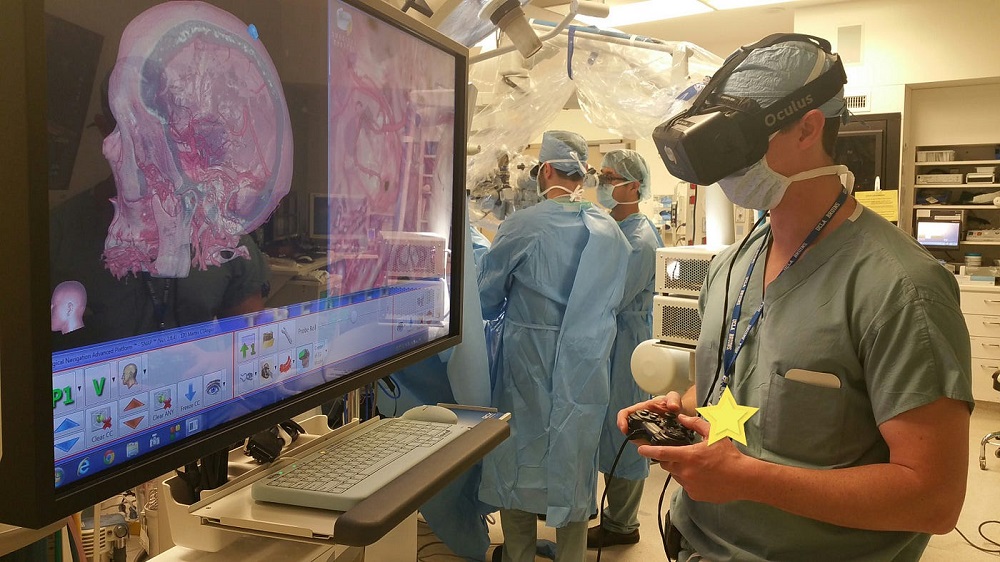 Source: Virtual Reality Pop
Source: Virtual Reality Pop
The advent of Virtual Reality (VR) nursing simulation has significantly advanced nursing education. The use of virtual reality in medical education has shown to be a game-changer as technology develops, transforming the educational process for aspiring nurses.
"Discover a new dimension of nursing education as you venture into immersive VR environments, revolutionizing the way you learn and practice essential healthcare skills."
1. How VR Technology is Applied in Nursing Training?
Nursing training programs utilizing virtual reality (VR) technology are meticulously crafted to be exceptionally immersive and interactive.
With the integration of VR for nursing education, students are transported into realistic, three-dimensional healthcare environments by donning virtual reality headsets.
This innovative approach not only ensures a heightened level of engagement but also allows learners to actively participate in lifelike scenarios, enhancing their practical skills and decision-making abilities.
The use of VR in nursing education represents a paradigm shift towards dynamic, hands-on learning experiences, demonstrating a commitment to staying at the forefront of technological advancements for more effective healthcare training.
With patient avatars, medical gear, and diverse healthcare scenarios, these virtual environments are intended to mimic hospital rooms, clinics, and emergency care units.
Nursing students can actively take part in patient care, conduct evaluations, reach clinical decisions, and communicate with virtual patients thanks to technology.
Students can experience touch thanks to cutting-edge haptic feedback devices, which further increases the realism of the simulation.
Additionally, students can speak with virtual patients to practice their communication skills in a realistic environment thanks to voice recognition and response capabilities.
2. Simulation Scenarios and Real-Life Applications
A wide range of scenarios that reflect the difficulties of providing healthcare in real life are offered through VR nursing simulators. Medical emergencies, a wide range of patient states, and challenging clinical scenarios can all be encountered by students.
VR offers a full platform to put theoretical knowledge into practice, from giving medications and keeping track of vital signs to handling unexpected catastrophes.
Additionally, several nursing specialties, including medical-surgical, pediatric, obstetric, and critical care, are catered to via VR simulators. Nursing students can investigate many specialties and gain knowledge in ones that fit with their professional objectives.
They have a deeper grasp of the nursing profession and are more equipped to handle the dynamic issues they may encounter in the future thanks to this exposure to a variety of situations.

Get the App from Meta Store: Download Now
3. Benefits of VR Nursing Simulation for Skill Development
Enhanced Clinical Decision-Making: Virtual reality nursing simulation gives students the ability to make important decisions in realistic situations.
Strong clinical decision-making abilities are encouraged as students experience numerous patient scenarios where they must evaluate symptoms, prioritize care, and take quick action.
Improved Assessment and Technical Skills: In a risk-free setting, nursing students can practice a variety of technical tasks like placing IV lines, caring for wounds, and doing physical examinations.
Their expertise and confidence in using these talents effectively are improved by repetitive practice.
Stress Management and Crisis Response: Students are exposed to the pressure and tension that come with important healthcare crises by participating in VR simulations.
As a result of this exposure, they are better able to manage their stress and develop the skills necessary to act calmly and effectively in an emergency.
Reflective Learning: Students are given quick feedback and performance ratings following each simulation.
Through this reflective learning process, students can pinpoint their areas for development and try to better those areas in the following simulations.
Time-Efficient and Cost-Effective: VR nursing simulations provide a scalable and affordable training solution, which optimizes time and resources. Institutions are able to host more students at once and use less costly physical simulation equipment.
The Impact of VR on Nursing Education
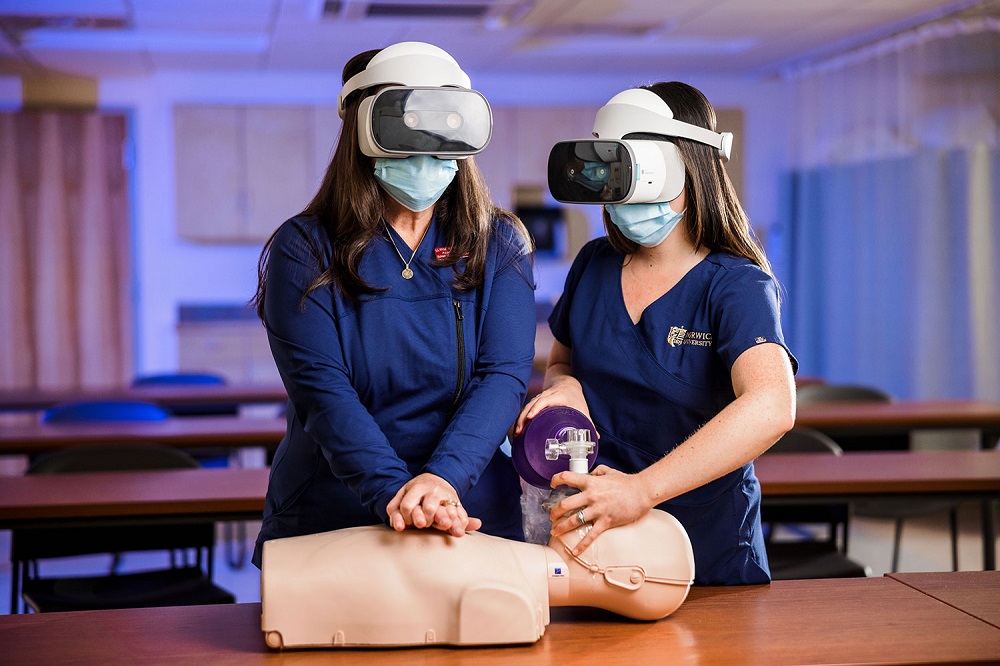 Source: Norwich University
Source: Norwich University
In nursing education, virtual reality (VR) has had a significant impact on how students study and become ready for their future employment as healthcare professionals.
Critical thinking, decision-making, teamwork, communication skills, empathy, and patient-centered care have all advanced significantly in nursing education because of the use of Virtual Reality.
1. Improving Critical Thinking and Decision-Making
Through immersive nursing simulations, students can experience challenging medical situations and make important decisions in real-time. Virtual reality (VR) pushes students to evaluate patient conditions, prioritize care, and make thoughtful decisions by placing them in genuine circumstances.
Students' capacity to think critically under pressure is improved by this practical experience, which also helps them to become better problem-solvers.
Additionally, when students deal with a variety of patient scenarios, they gain a thorough awareness of the complexity of healthcare, developing their clinical judgment and decision-making skills.
2. Promoting Team Collaboration and Communication Skills
Communication and collaboration are essential for providing good healthcare. The interdisciplinary team settings that need students to work with other healthcare professionals, such as doctors, pharmacists, and therapists, are simulated in VR nursing simulations.
These situations teach nursing students how to collaborate, exchange information, and communicate effectively in order to offer the best possible patient care.
Due to the immersive nature of VR, students are more likely to participate actively in these team-based simulations, improving their interpersonal abilities and inter-professional communication.
3. Fostering Empathy and Patient-Centered Care
Nursing practice is centered on compassion and patient-centered care. By enabling nursing students to view healthcare scenarios from the patient's perspective, virtual reality (VR) aids in the development of a more profound sense of empathy.
Students can better comprehend the anxieties, worries, and emotions of virtual patients when they interact with them, which improves their capacity to offer compassionate care.
Students are also required to respond to patient emotions and behaviors in VR simulations, which helps them develop their listening, empathy, and responsiveness skills.
Additionally, virtual reality (VR) enables nursing students to practice patient-centered care in a risk-free setting. This offers a secure environment for learning from errors, receiving criticism, and continuously enhancing patient interactions.
Nursing students are better prepared to deliver sympathetic and compassionate care if patient-centered care is promoted early in their education.
Incorporating VR in Nursing Curriculums
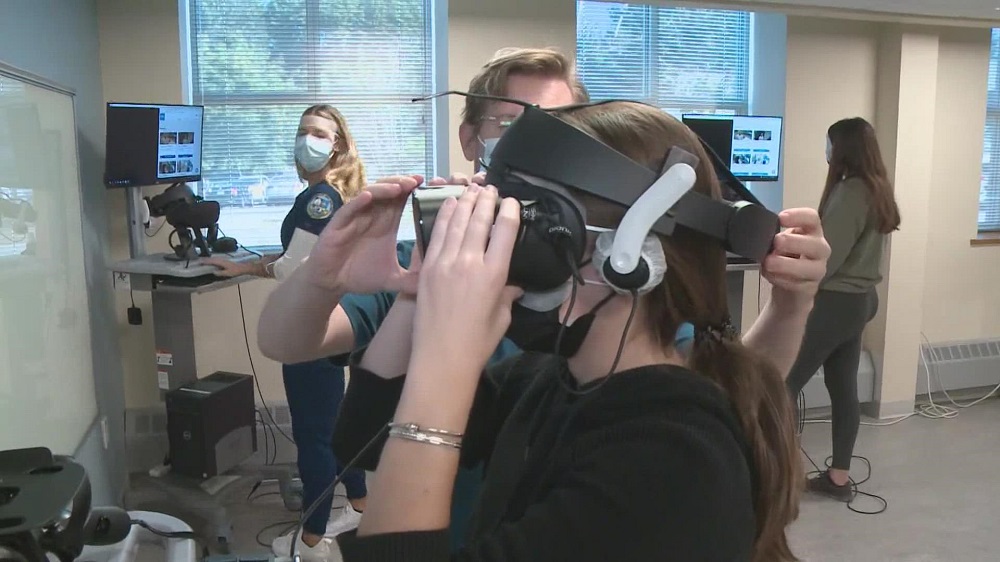 Source: NEWS CENTER Maine
Source: NEWS CENTER Maine
Nursing schools need to create efficient plans for incorporating this game-changing technology into their curricula as Virtual Reality (VR) continues to redefine nursing education.
A thorough and effective educational experience for nursing students can be produced by working with VR developers and investigating its deployment across different nursing specializations.
1. Strategies for Successful Integration of VR Technology
Nursing schools may fully utilize VR to provide their students with an engaging, immersive, and all-encompassing learning experience that will better prepare them to succeed in the rapidly changing healthcare industry by implementing the following strategies:
Needs Assessment: Perform a detailed requirements analysis to pinpoint the precise areas in which VR might improve nursing education.
To ensure alignment with the whole nursing curriculum, identify the learning objectives and competencies that can be addressed through virtual reality simulations.
Faculty Training and Support: Offer faculty members in-depth instruction on VR technology and its use in nursing education.
Help them create and implement VR-enhanced lesson plans so that students have a seamless and interesting learning experience.
Gradual Integration: Integrate VR gradually into the nursing curriculum by starting with straightforward situations and working your way up to more intricate simulations.
Students can become accustomed to the technology and gain confidence in using VR for studying thanks to this step-by-step approach.
Interdisciplinary Integration: Create interdisciplinary VR scenarios by working with different healthcare specialties like medicine and pharmacy.
Interprofessional education promotes cooperation and improves students' capacity for teamwork in actual healthcare settings.
Continuous Evaluation and Improvement: Monitor student feedback and performance ratings to see how well VR integration is working. Utilize this information to enhance the VR simulations and modify the educational experience to the needs of the pupils.
2. Collaborations between Nursing Schools and VR Developers
Virtual Reality (VR) technology integration in nursing education has opened up new avenues for educating future nurses to suit the changing demands of the healthcare industry.
The adoption of this cutting-edge technology by nursing schools is vital, and forming partnerships with VR developers is the key to providing immersive and meaningful learning opportunities for nursing students.
Aligning Educational Objectives: Effective collaborations start with a mutual knowledge of the teaching goals of the nursing school and the capabilities of VR technology.
Nursing schools and VR developers can collaborate to create simulations that satisfy specific learning objectives by coordinating their respective views. This will guarantee that the VR content is pertinent to and helpful for nursing education.
Tailored VR Simulations: Depending on their student body and specialty areas, nursing schools frequently have particular curricular needs.
Working with VR programmers enables the development of specialized VR simulations that cater to these particular needs.
A more relevant and authentic learning experience is guaranteed by customized VR content, regardless of the subject matter—medical-surgical nursing, children's health, mental health, or other disciplines.
Evidence-Based Content: VR developers can offer their skills in creating simulations based on real-world medical settings.
Collaborations with nursing schools give creators insightful knowledge into the difficulties nursing students experience, resulting in VR material that is in line with current medical procedures and standards.
Technological Advancements: To enhance the VR learning experience, VR developers are constantly incorporating cutting-edge developments.
Nursing schools can access the most recent VR advancements by collaborating with developers, guaranteeing that their students receive cutting-edge instruction that will prepare them for the contemporary healthcare environment.
Faculty Training and Support: Collaborations involve faculty training and support in addition to the creation of VR content. In order to properly include VR simulations in their teaching techniques, nursing school professors might get help from VR developers.
The easy incorporation of VR into the curriculum is ensured by this support, which also maximizes the potential influence on student learning.
Research and Evaluation: Through cooperative efforts, nursing schools can take part in studies looking into the efficiency of VR in nursing education.
Nursing programs and VR developers can add to the expanding body of research that shows how valuable VR simulations are for enhancing clinical proficiency and patient outcomes by conducting joint investigations.
Continuous Improvement: An iterative process of continuous improvement is fostered by strong teamwork. Nursing schools may provide vital insights to VR developers in order to continuously improve the VR material by obtaining input from nursing students and teachers
Cost-Effectiveness: A cost-effective method for integrating sophisticated simulations into nursing education is to collaborate with VR developers.
Nursing schools can use virtual reality (VR) technology to give an immersive learning experience rather than spending money on pricey physical simulation equipment.
3. Implementing Virtual Reality in Different Nursing Specialties
There is a significant transformation of medical education with VR. Utilizing VR in various nursing specializations, including medical-surgical nursing and mental health care, provides nursing students with specialized learning opportunities.
The use of virtual reality in various nursing specializations equips nursing students with competencies and skills unique to that discipline.
Nursing schools may make sure that students receive thorough training that equips them to deliver specialized care across various healthcare settings by providing targeted and realistic simulations.
Medical-Surgical Nursing: Develop VR simulations that highlight various medical-surgical situations, including wound care, post-operative treatment, and challenging patient assessments.
In a lifelike virtual setting, students can practice difficult nursing techniques including catheterization, nasogastric tube insertion, and dressing changes.
Furthermore, in order to assist students develop competence in a variety of medical-surgical situations, the VR for surgical training can recreate a variety of patient scenarios, from chronic illnesses to acute medical emergencies.
Pediatric Nursing: Through VR, students can experience caring for children with chronic conditions, supporting their emotional and psychological well-being in a safe and controlled environment.
Create virtual reality (VR) settings that let students converse with computer-generated children so they can improve their evaluation and communication abilities.
The management of juvenile illnesses, monitoring growth and development, and offering family-centered care are just a few of the difficulties that these simulations can solve in terms of pediatric health.
Through virtual reality, students can practice supporting the emotional and psychological well-being of children with chronic illnesses in a secure setting.
Obstetric and Maternal Health Nursing: Prepare students for maternity care circumstances by using VR to simulate childbirth, prenatal care, and neonatal resuscitation scenarios.
Students can participate in virtual prenatal exams, prenatal education, and labor support, which will improve their capacity to offer thorough obstetric care.
Critical Care Nursing: To manage emergencies in the intensive care unit, like reacting to cardiac arrests and acute respiratory distress, provide VR simulations.
These simulations can help students develop their clinical and critical thinking abilities by addressing critical care scenarios such as managing mechanical breathing, hemodynamic monitoring, and sepsis.
In order to prepare them for the difficulties of intensive care nursing, students might use VR to practice collaboration and communication in high-stress critical care scenarios.
Mental Health Nursing: For students concentrating in mental health nursing, create VR scenarios that examine mental health assessments, therapeutic communication, and de-escalation methods.
By interacting with virtual patients who are experiencing various mental health illnesses like schizophrenia, depression, and anxiety, students can develop empathy and understanding.
Nursing students can practice interventions that support mental wellness and recovery in a safe environment using virtual reality, preparing them for the complexity of mental health nursing.
VR for Nurses: Continuing Education and Lifelong Learning
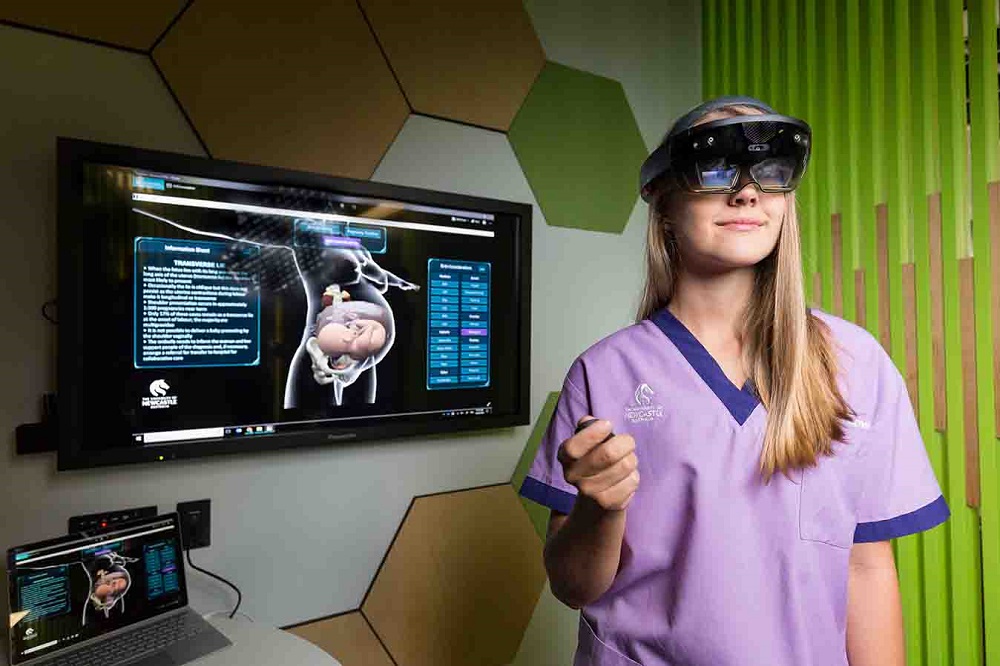 Source: anmj.org.au
Source: anmj.org.au
The use of virtual reality in nursing continuing education and lifelong learning has grown significantly. VR offers many benefits for continued professional development, keeping nurses current with technological breakthroughs, and offering remote and worldwide learning options as the healthcare sector constantly changes.
1. Advantages of VR in Ongoing Professional Development
The benefits of VR for medical training, especially for nurses' continued professional growth are numerous. It is an indispensable tool for enabling nurses to deliver great patient care and maintain their position at the top of their field because of its realistic and immersive learning experience, hands-on skill development, access to rare situations, instant feedback, flexibility, and cost-effectiveness.
Lifelike Simulations: Through the use of virtual reality, nurses can practice their abilities, make important decisions, and react to a range of patient circumstances through lifelike simulations of medical scenarios. Their clinical competency is improved, and it encourages lifelong learning.
Access to Rare Cases: Virtual reality (VR) technology enables nurses to access simulations of uncommon and complex medical cases that they might not regularly meet in practice. The experience helps nurses become competent and confident in handling unusual situations.
Immediate Feedback and Assessment: Real-time feedback and assessment are provided via VR simulations, allowing nurses to evaluate their performance and pinpoint areas for development. This feedback loop encourages ongoing self-evaluation and improves professional growth.
Safe Learning Environment: Virtual reality (VR) offers nurses a secure setting in which they can learn and make mistakes without endangering patient safety.
Better learning results result from the encouragement of experimentation and discovery in this risk-free learning environment.
Cost-Effective Learning: VR provides a more affordable alternative to traditional in-person workshops and training programs for ongoing education.
A variety of VR learning modules are available to nurses without the expense of costly travel or specialist equipment.
2. Keeping Up with Technological Advancements in Healthcare
VR technology has a big impact on how patient care is provided, how outcomes are improved, and how efficiently healthcare is delivered. Nurses must adopt a proactive attitude to ongoing learning and professional development if they are to keep up with these improvements.
Cutting-Edge Medical Innovations: VR enables nurses to become familiar with the most recent medical advancements and technologies.
They can practice using cutting-edge medical technology and keep abreast of how the healthcare industry is changing.
Training for New Procedures: As medical procedures and treatments develop, virtual reality in medical education offers nurses the chance to develop their abilities to carry out novel procedures in a safe and realistic setting.
Digital Health and Telemedicine: VR helps nurses to investigate telemedicine and digital health applications, preparing them for the incorporation of technology into healthcare delivery. This knowledge equips nurses to provide patient care in the digital era.
3. VR Solutions for Remote and Global Learning
Virtual reality (VR) provides creative, immersive solutions that cut beyond geographical boundaries. VR has emerged as a disruptive technology that allows students from all backgrounds and regions to access top-notch educational experiences as the globe becomes more connected.
Accessible Learning: VR eliminates geographic boundaries and makes high-quality education and training available to nurses who live in distant or underserved places.
It democratizes educational options, increasing inclusivity and accessibility in continuing education.
International Collaboration: VR enables nurses to collaborate and share knowledge internationally. It enables nurses from other nations to participate in online conferences, workshops, and training sessions, encouraging a variety of ideas and best practices to be shared.
Cultural Competence: The inclusion of culturally varied patient scenarios in VR simulations can aid in the development of nurses' cultural sensitivity and empathy for patients from various backgrounds.
Overcoming Challenges and Concerns
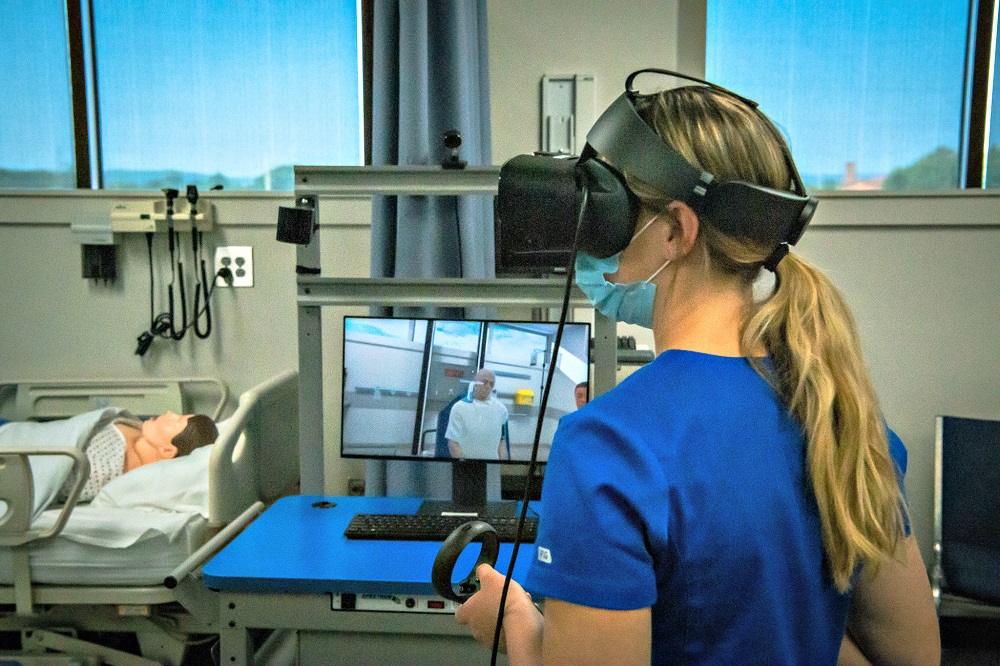 Source: Oxley College of Health Sciences - The University of Tulsa
Source: Oxley College of Health Sciences - The University of Tulsa
While the use of virtual reality in nursing education has enormous promise, its effective implementation depends on overcoming technological obstacles, assuring its ethical application, and offering faculty members assistance and training.
Nursing schools may fully utilize the advantages of VR for medical education by proactively addressing these issues and better educating future nurses for the ever-changing healthcare environment.
1. Addressing Technological Barriers and Costs
There are financial and technological obstacles to implementing Virtual Reality (VR) technology in nursing education.
Nursing schools may build a solid foundation for integrating VR into their educational programs by overcoming these technology limitations and expenses.
For VR to fully realize its promise as a cutting-edge and strong educational tool, these obstacles must be overcome.
Access to VR Equipment: Securing access to VR equipment is one of the main hurdles in using VR in nursing education. Because VR headsets and simulation software can be pricey, some institutions find it challenging to invest in the technology.
Solution: Working with VR vendors and developers can result in more economical options like leasing or group purchases.
Additionally, nursing schools can look into collaborations with nearby healthcare facilities or hospitals that may already have VR teaching technology.
Infrastructure and Connectivity: Virtual reality simulations demand powerful computers and a steady internet connection. The quality of the VR experience can suffer in areas with spotty high-speed internet access.
Solution: To facilitate VR teaching, nursing schools can improve their network infrastructure. They can also look into offline VR training options for places with spotty internet connectivity.
Technical Support and Maintenance: In order to ensure that VR technology is operating correctly, it has to get regular maintenance and technical assistance.
Finding trained employees to handle and troubleshoot VR technology may be difficult for institutions.
Solution: These issues can be successfully resolved by setting up a specialized technical support team or contracting out maintenance work to VR providers.
2. Ensuring Ethical Use of VR in Nursing Education
It is crucial to respect ethical standards and ensure the safe use of this potent instructional tool as nursing schools include VR in their curricula.
Protecting patient rights, student well-being, and the integrity of the educational process are all benefits of including ethical issues in VR nursing education.
Patient Privacy and Confidentiality: In VR simulations including patient scenarios, patient privacy and confidentiality must be respected. Students should get instruction on the moral use of patient data in VR settings.
Solution: Implement strict data protection measures, de-identify patient information in VR scenarios, and ensure that learners are aware of the importance of patient privacy.
Emotional and Psychological Impact: VR simulations have the potential to arouse intense emotional reactions in learners, particularly in cases where crucial patient care or terrible events are involved.
Solution: After VR simulations, hold debriefing sessions to aid learners in processing their feelings and experiences. Faculty members ought to receive training so they can assist students psychologically if they do.
Informed Consent: Learning participants in VR simulations should give informed consent after understanding the experience's nature and potential effects.
Solution: Include a permission process in the VR training that explicitly explains the simulation's goal and the participants' rights.
3. Faculty Training and Support in VR Integration
In order to properly implement Virtual Reality (VR) technology into nursing education, faculty members must have the essential abilities and expertise.
In order to successfully integrate VR, faculty training and assistance are essential because they enable educators to fully utilize VR's potential to improve the learning environment for nursing students.
Lack of Familiarity with VR Technology: Teachers may not have enough experience or confidence to use VR technology in the classroom.
Solution: Provide thorough training sessions for educators so they are aware of VR technology and how it is incorporated into the nursing curriculum..
Developing VR Content: Faculty members can lack the necessary skills to produce high-quality, discipline-specific VR material.
Solution: Encourage collaboration between VR simulation creators and nursing academics to provide specialized and fact-based VR simulations.
Integrating VR into Existing Curricula: In programs with a long history, it can be difficult to seamlessly incorporate VR into the nursing curriculum.
Solution: Encourage professors to include VR into the curriculum gradually by starting with smaller, trial projects. This methodical methodology enables evaluation and modifications as necessary.
Future Prospects of Virtual Reality in Nursing Education
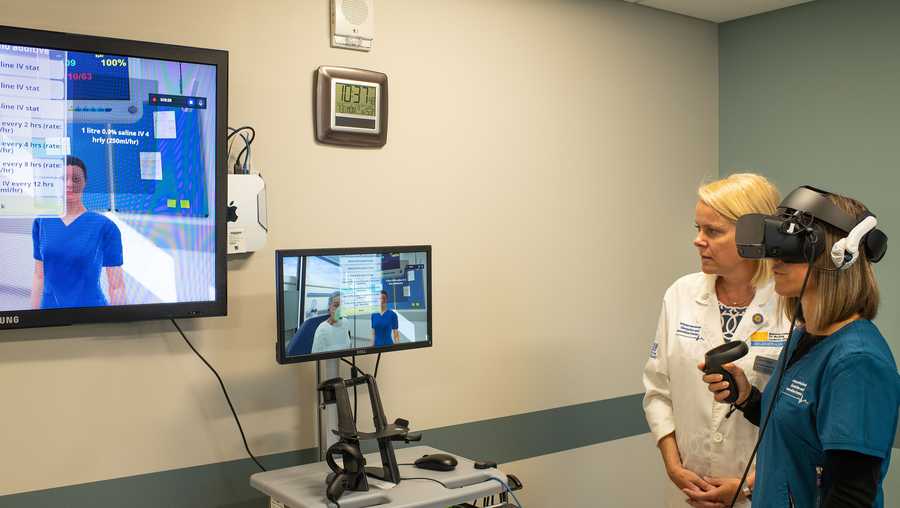 Source: KCRA
Source: KCRA
With its ability to provide students with immersive and life-changing learning experiences, virtual reality (VR) has already made great progress in the field of nursing education.
The potential of virtual reality (VR) in nursing education holds enormous promise for influencing patient care and healthcare education in the future as technology develops.
Here is how the metaverse can change medical education with Virtual Reality in the future:
1. Ongoing Research and Development in VR Technology
VR technology is still being developed and researched. Researchers and developers are working hard to improve VR technology, software, and applications as demand for them increases in healthcare and nursing education.
Advancements in VR Hardware and Software: Ongoing research and development will provide more advanced and user-friendly VR products.
The whole VR experience for nursing students will be improved by lighter, more comfortable headsets with better resolution and motion-tracking features.
Haptic Feedback and Sensory Integration: As haptic feedback technology advances, learners will be able to feel genuine tactile sensations, enhancing the immersion in VR simulations.
Including other senses like touch and scent will make virtual worlds feel even more real.
Artificial Intelligence (AI) Integration: AI will be used in VR simulations to create dynamic, adaptable settings that react to the choices and actions of the learners.
Virtual patients and teachers powered by AI can offer individualized feedback and support catered to specific learning needs.
Along with AI, VR simulations will also be used with AR in medical education.
2. Predictions for VR's Role in Shaping the Future of Nursing Education
Virtual Reality (VR) technology has already demonstrated its potential in transforming nursing education, and its role is expected to expand significantly in shaping the future of healthcare education.
As technology continues to evolve, here are some predictions for VR's impact on nursing education:
Mainstream Integration into Nursing Curricula: VR will become a mainstream component of nursing curricula, supplementing traditional teaching methods with hands-on, interactive, and realistic simulations.
From nursing fundamentals to specialty areas, VR will play a pivotal role in skill development and critical thinking.
Remote and Global Learning Opportunities: VR will bridge geographical distances, allowing nursing students from diverse locations to collaborate, learn, and share experiences in virtual classrooms.
Learners will access global conferences, workshops, and simulation training without leaving their institutions.
Enhanced Interprofessional Education: VR will facilitate interprofessional education, bringing together students from various healthcare disciplines to collaborate and solve complex patient care challenges.
Nursing students will learn to work seamlessly with other healthcare professionals, fostering team-based care.
Virtual Clinical Placements: VR will enable nursing students to engage in virtual clinical placements, practicing in a wide range of healthcare settings and patient scenarios.
This will supplement traditional clinical experiences, ensuring exposure to diverse patient populations and conditions.
3. Potential Impact on Healthcare Delivery and Patient Outcomes
The integration of Virtual Reality (VR) technology in healthcare delivery and nursing education has the potential to bring about significant improvements in patient outcomes and healthcare practices.
As VR applications in Medical Education continue to advance, the impact on healthcare delivery is becoming increasingly evident:
Improved Patient Safety and Quality of Care:
Nursing graduates trained in VR will enter the workforce with enhanced clinical competencies and critical thinking skills.
This will translate into improved patient safety, as nurses will be better prepared to handle challenging situations and make informed decisions.
Decreased Healthcare Costs and Resource Utilization:
VR training will reduce the need for physical resources and costly training scenarios, making nursing education more cost-effective. By simulating patient care scenarios, nurses will be better equipped to manage complex cases, potentially decreasing hospital readmissions and unnecessary resource utilization.
Technologically-Advanced Healthcare Workforce:
VR will prepare nurses for the rapid technological advancements in healthcare, ensuring a workforce ready to embrace digital health solutions, telemedicine, and other emerging technologies.
Advancements in Healthcare Research:
The use of VR in healthcare education will lead to research opportunities exploring the impact of immersive learning on clinical outcomes, patient satisfaction, and healthcare workforce readiness.
Conclusion
In conclusion, Virtual Reality (VR) technology has the power to revolutionize nursing education and healthcare delivery.
Through immersive learning experiences, nursing students gain enhanced clinical competence and critical thinking skills.
VR's role extends beyond the classroom, facilitating interprofessional collaboration and global learning opportunities.
As VR becomes mainstream in nursing curricula, personalized learning pathways and ongoing professional development will shape a technologically adept nursing workforce.
Embracing VR offers transformative benefits in telemedicine, patient education, and evidence-based practice, ultimately improving patient outcomes and addressing healthcare disparities.
While ethical considerations and technological challenges must be addressed, VR's potential to redefine nursing education and elevate healthcare delivery is undeniable.
The future of nursing education is indeed immersive, patient-centered, and technologically advanced.




